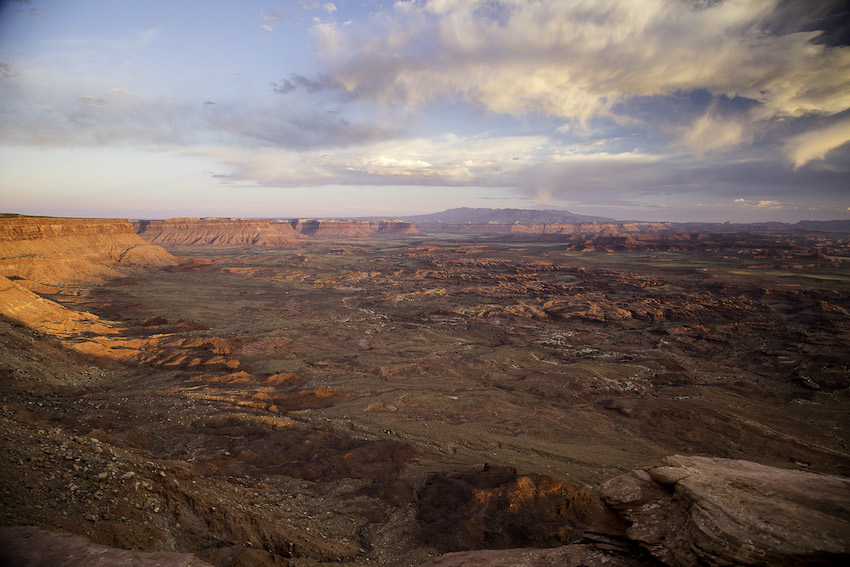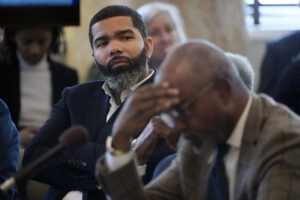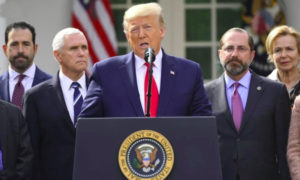Native Voices Unite to Defend Sacred Lands
As a lawsuit challenges the slashing of the Bears Ears Monument, Native Americans point to the area's spiritual and cultural significance. Sunset at the Indian Creek area of the Bears Ears National Monument in Utah. (U.S. Bureau of Land Management)
Sunset at the Indian Creek area of the Bears Ears National Monument in Utah. (U.S. Bureau of Land Management)

Purchase in the Truthdig Bazaar
“Edge of Morning: Native Voices Speak for the Bears Ears”
A book edited by Jacqueline Keeler
In the final month of his administration, Barack Obama designated 1.35 million acres in Utah as the Bears Ears National Monument. A year later, Donald Trump slashed the expanse by 85 percent, leaving about 200,000 acres under federal protection.
Trump said he reduced the size of Bears Ears to combat government overreach, but critics claim the move opened the area to mining and drilling. The Washington Post discovered that a uranium company had conducted an intensive lobbying campaign to cut down the amount of protected land.
Native tribes, environmentalists and concerned businesses such as Patagonia have filed a lawsuit that claims the executive branch lacks authority to alter the size of national monuments. If the suit fails, no designated national monument is safe, according to the Los Angeles Times.
“Edge of Morning: Native Voices Speak for the Bears Ears,” edited by Jacqueline Keeler and featuring essays, interviews and poetry by Native American writers, addresses the issue at the heart of all the political and legal wrangling: For Native Americans, the Bears Ears land is an endangered, irreplaceable spiritual and cultural center. The book describes the unprecedented collaborative process that preceded the national monument designation. Even more importantly, it articulates the nature and depth of Native American ties to the land. We learn about the Bears Ears in particular, but the greater lesson deals with culture, identity and, as one writer says, “what it means to be human.”
Click here to read long excerpts from “Edge of Morning” at Google Books.
Thirteen native tribes have cultural ties to the Bears Ears land, and leading up to Obama’s designation, five of those tribes joined forces to push for federal protection of the area. The Bears Ears was important enough for the tribes to bury their historical differences, according to “Edge of Morning” contributor Regina Lopez-Whiteskunk:
“The proposal we developed is absolutely unique because the five tribes that came together to organize this group really, truly represent a sense of healing within. When Navajos and Hopis can sit together in one room and have the same common goals—likewise, the Navajo and the Ute. These tribes on both sides have been traditionally great enemies for many generations. This is actually a phenomenal change—that we can come to see something in common instead of seeing our differences. …
“I recall the day that we came together and said we’re going to do this. I remember one of the discussions, specifically, was we would leave all other politics out of the ring when we gather to speak about Bears Ears.”
The result was a groundbreaking proposal that native tribes and the U.S. government work collaboratively to manage the land within the Bears Ears National Monument. But in October 2017, as the Bears Ears Commission of Tribes prepared to meet with federal representatives to discuss implementing this joint management, Trump made his decision to decimate the national monument.
“Edge of Morning” contributors range from intertribal coalition members such as Lopez-Whiteskunk to seasoned writers including former Oregon Poet Laureate Elizabeth Woody. The contributors present different perspectives according to their interests and expertise, so the book provides a well-rounded look at the present and historical significance of the monument land.
Some writers concentrate on the importance of cultural preservation at Bears Ears. The area contains remains of ancient homes, artifacts of daily life and invaluable cliff drawings, all endangered without federal protection. A critical part of cultural preservation is allowing native people to experience the natural setting of their forebears, archaeologist Lyle Balenquah explains in the book:
For millennia … ancestors of modern Hopi people lived in this region, refining the practical knowledge and spiritual energy that allowed them to not only exist, but thrive in a seemingly harsh environment. This knowledge and experience would be passed from generation to generation, ultimately culminating and expressed in the contemporary culture of Hopi people, reflecting a connection that spans thousands of years across hundreds of miles. …
The Bears Ears movement is about more than just preservation for preservation’s sake. … It’s about the protection of Indigenous cultures so that we retain our ability to pass on our traditional knowledge to future generations.
Several contributors address the spiritual significance of Bears Ears. “Bears Ears [is sacred land] to our people, a place where our Ancestors worshipped and were buried,” activist Wayland Gray writes.
Gray and Klee Benally, another activist who contributed to “Edge of Morning,” compare Bears Ears to other sacred sites that have come under attack, including Hickory Ground in Alabama, where a casino was built on a native graveyard, and Arizona’s San Francisco Peaks, a historically spiritual area that was desecrated when a ski resort covered the area with fake snow made of treated sewage.
Benally describes a condition called “land trauma,” in which attacks on their lands cause Native Americans spiritual and emotional pain. The U.S. government has recognized the validity of this trauma in theory but not in practice, Benally says.
In a 2012 draft review of policy on native sacred sites, the U.S. Department of Agriculture and the Forest Service agreed that protection of those sites is critical. “We … recognize that the continued existence of and access to Native American Sacred Sites is an important component of healing,” the document stated. “To disregard the value of Native American Sacred Sites would perpetrate the cycle of trauma.”
On the day this report came out, Benally and three others were arrested for peacefully protesting the Forest Service’s role in allowing treated-sewage snow on the San Francisco Peaks.
To the contributors in “Edge of Morning,” the fight to protect Bears Ears is critical because, as Gray says, every defeat makes it easier for other areas to be desecrated.
Gray writes, “Our connections to our ceremonial and burial grounds and sacred places make us who we are as Native People. … We must stand united and support each other to protect all of the sacred places of our nations.”
In addition to the cultural and spiritual value of Bears Ears, writers such as Lopez-Whiteskunk contribute personal reasons for the area to remain protected.
Lopez-Whiteskunk writes:
“And so, for my family, Bears Ears was a very central location for us. I’ve had … grandparents and family members who were raised in that area. Families that can show where their watermelon patch used to be or their orchards, where they grew up as children running and playing in the meadows and down near where the water was. They can tell of when they had to haul water from the waterways back to their camps where they were living. And my grandmother Stella Eyetoo can tell stories about their lives in Bears Ears right to the point where the federal government came and took them away to boarding school.”
“Edge of Morning” is written in a straightforward style, but the words are so passionate they border on poetry. Each chapter delivers a powerful message—usually one of continuity, spirituality and hope for the future in spite of a devastating past. I gained something from every passage—either new information or, more often, an expanded appreciation of Native American values and experiences.
Martie Simmons, another “Edge of Morning” contributor, adds a personalized plea to protect Native lands such as Bears Ears. Connecting history and humanity’s basic needs, she writes:
“Because of the resilience of my ancestors, I now have the capability to pass on stories, history, language, and culture to my children. I can show my children the land that their ancestors fought for and some even died to preserve. This is where they belong; this is where they will always have a home. At the end of the day, isn’t that where we all want to be?”
Your support matters…
Independent journalism is under threat and overshadowed by heavily funded mainstream media.
You can help level the playing field. Become a member.
Your tax-deductible contribution keeps us digging beneath the headlines to give you thought-provoking, investigative reporting and analysis that unearths what's really happening- without compromise.
Give today to support our courageous, independent journalists.









You need to be a supporter to comment.
There are currently no responses to this article.
Be the first to respond.